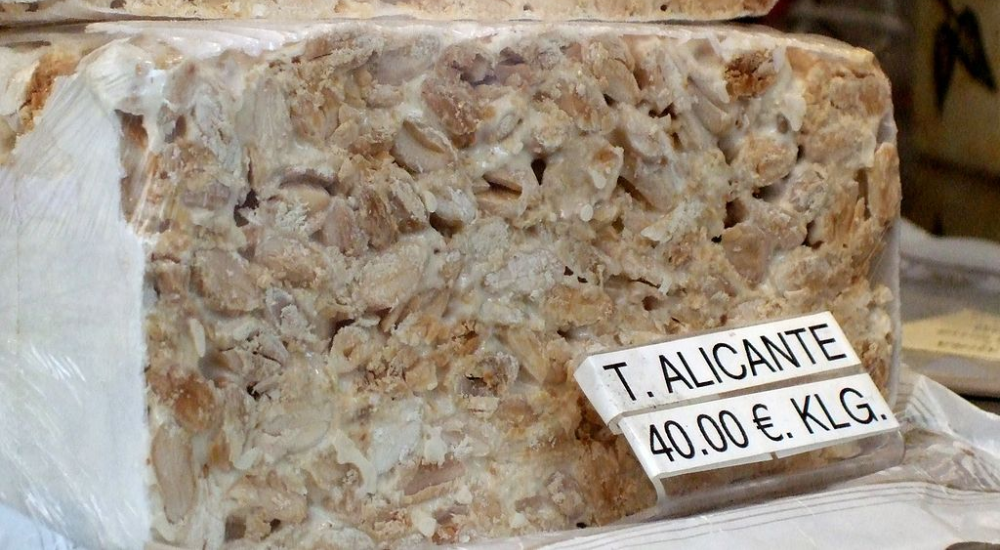
One of the most popular sweets to eat at Christmas is turrón and it is a very typical festive dessert across much of southern Europe but particularly in Spain. And it is our little corner of the country where this type of nougat is produced for consumption across the country and beyond. Supermarkets stock great bars of turrón all year round but it is at Christmas time when the great demand means that you will see it everywhere, especially in the Christmas markets.
Its origin can be traced back to Ancient Greece when Olympic athletes consumed a nougat before competitions due to its high protein content whilst there are written references to a type of nougat during Roman times.
However, perhaps the most favoured origin, especially for its arrival in Spain, is Arabic and the sweet would arrive on the Iberian peninsula with the Muslim invasion of the 8th century. There is no doubt that the Spanish version of this nougat developed in what is now the Province of Alicante during the 15th century and there is documentary evidence dating from 1582 that the city of Alicante paid its employees their Christmas bonus partly in money and partly in turrón.
Sugar was added to the production of the nougat in the 18th century, coinciding with the establishment of massive plantations of sugar cane in the Americas and the opening of free trade between the colonies and Spain, and this version became known as “turrón de nieve”.
Spain is the world’s leading producer of turrón and other Christmas sweets such as marzipan and it is exported across the world, including the Far East and Japan and even to traditional sweet exporters such as the United Kingdom, Germany and France. In 2015, the industry was worth more than 440 million euros.
When buying turrón, it is important to look for “Calidad Suprema” on the packaging which means that it contains at least 60% almonds for Turrón de Alicante and at least 64% almonds for the softer Turrón de Jijona. Those packets marked “Calidad Extra” are cheaper but it doesn’t actually mean anything. Some companies offer “Calidad Oro” which can contain around 70% almonds and costs a lot more.
Two of the best known brands of turrón are el lobo and 1880 from Almendra y Miel, a company run by a family that has been producing turrón for almost 300 years over ten generations. They have a large production plant just outside Jijona as well as a museum where you can learn more about turrón, its history and its production; see the link below.
Although many types of turrón are made in Latin America, the best-known production area is the Province of Alicante, concentrated around Jijona and Biar, which produces two types, Turrón de Alicante and Turrón de Jijona, both of which form part of a typical Spanish Christmas gastronomic experience.
Turrón de Alicante PGI
Also known as “hard turrón”, Turrón de Alicante is made of lightly toasted almonds mixed with honey and its production is strictly controlled so that it all meets the necessary requirements to belong to the EU’s Protected Geographical Indication (PGI) initiative, which emphasises the relationship between the specific geographic region and the name of the product.
The main ingredient is the almond and the turrón must have at least 46% of its content weight attributed to it. The almonds are peeled and toasted in rotating drums before diluted egg white is added as a whitening agent. The honey, which must be from the Comunidad Valenciana, is heated and added to the toasted almonds before the resulting mixture is poured into molds covered with wafers.
At Christmas time, it is usually broken into pieces and served on a plate with other festive sweets such as polvorones (crumbly shortbread cookies), marzipan and peladillas (sugared almonds).

Turrón de Jijona PGI
Jijona (Xixona in Valencian) is a small town about 22 kilometres north of the city of Alicante which is world famous for its production of turrón, not only as a bar but also as an ice cream and in many places across Spain – including Xàbia – you will find ice cream parlours called “La Jijonenca“.
Also known as “soft turrón”, Turrón de Jijona is made of ground almonds mixed with honey and, much like Turrón de Alicante, its production is strictly controlled so that it all meets the necessary requirements to belong to the EU’s Protected Geographical Indication (PGI) initiative. Unlike Turrón de Alicante, the Jijona version is characterized by the pasty texture of the ground almonds mixed with the honey. It also has a lower proportion of the dried fruit than the Alicante version.
The mixture is ground down in special mills before being cooked in special cauldrons called “boixets”. It is then poured into molds and allowed to cool; it is important that the turrón is allowed to rest for at least 24 hours due to the release of oils from the almonds during the grinding process.
As with Turrón de Alicante, the Jijona version is often served at Christmas time with other festive sweets.

Learn More …
To learn more about turrón, its history and how it is made, you can visit the Museo del Turrón which located on an industrial estate about 3½ kilometres south of Xixona and is open everyday all year round except Sunday and Bank Holidays. There are eight guided tours each day – a couple more in the summer – and you have to chance to taste some of the products at the end. Note that the production zone where you can watch the manufacturing process is open from Mid-July to November only. See the website for more details.
MUSEO DEL TURRÓN
www.museodelturron.com
Polígono Industrial Ciudad del Turrón – Pol. Espartal II
Carretera Busot km1. 03100
Xixona – Alicante

